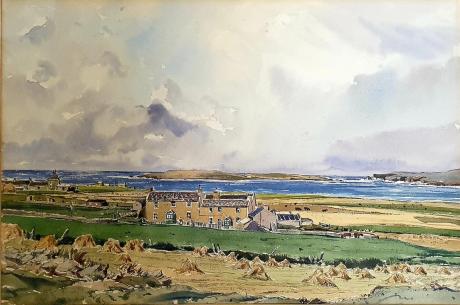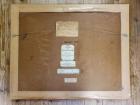signed and dated "sept 1954" further inscribed on the reverse "1233A" on the reverse
Rowley Gallery
Paul Watson Sparkford Somerset
Spring exhibition of watercolours Old Music School Sherborne 1982
Eynhallow (Scots: Eynhallow; Old Norse: Eyinhelga; Norn: Øjinhellig) is a small, presently uninhabited island, part of Orkney, off the north coast of mainland Scotland
Eynhallow lies in Eynhallow Sound between Mainland, Orkney and Rousay. It is 75 hectares (0.29 square miles) in area. An unnamed skerry is situated approximately 100 metres (330 feet) to the north-east of the island, separated by Fint Sound. Sheep Skerry adjoins the southern end of the island. There is no ferry to the island, although Orkney Heritage Society organises a trip each July.[9] Otherwise, visitors have to arrange their own transport to the island by private local boat hire. Access can be problematic, as there are strong tidal surges in the surrounding strait, squeezed between Mainland of Orkney and Rousay. The island's main attraction is Eynhallow Church dating from the twelfth century or earlier, and perhaps originally part of a monastery. The site is maintained by Historic Scotland. In 1841 the island had a population of 26. It has been uninhabited since the landowner cleared crofters away in 1851. The clearing led to the discovery of the church ruins, forgotten until then. It is now a bird sanctuary. It has its own folklore, concerning the initial finding of the island. Eynhallow was believed to be the summer residence of the shape-shifting mer-people the Finfolk, who were driven away by the farmer, Guidman o' Thorodale from Evie.
Abandoned in 1851, the 75-hectare island is surrounded by ferocious tidal races - known in Orkney dialect as "roosts. These roosts are at their most spectacular when the wind is in the north-west and a strong tide is running. Now uninhabited, Eynhallow - the Norsemen's Eyin Helga, Holy Island - has a special place in Orkney tradition and folklore. Originally believed to be the summer home of the Finfolk, the island was wrested from them by the guile of an Orkney farmer.
At its centre, stands the ruins of a chapel, which may have formed part of an early Christian monastic settlement. But although we now know of its ecclessiastical origins, it was not always so. Standing by the skeletal remains of two old houses, it is immediately clear why the original purpose of the Eynhallow kirk remained unknown for over 400 years. It is, quite simply, decidedly un-churchlike.
Although the structure not only served the spiritual needs of the island's early population, from the 16th century, it was used as a dwelling by a number of the islanders. Their later structural additions - a complex of thatched roof cottages - served to mask the building's original role, until, in 1851, disease and death among the four families who lived there led to the evacuation of the island.
The site was abandoned, and Eynhallow left to seabird and seal. This disease is traditionally said to have been typhoid, ascribed to the well, Kairikelda, which it is claimed, lay below a midden which polluted the water supply. How much truth is in this remains unknown.
Following the outbreak, and to make the buildings uninhabitable, the roofs were torn off. It was only then that it became clear that an ancient church lay at the core of the complex. From the outside, the modern visitor would still be hard-pressed to guess at the original function, but once inside, the sight of two ornate stone arches makes it immediately apparent. Built to a Romanesque design, the church has a rectangular nave, opening at the east end into a rectangular chancel. At the west end was a substantial square porch - which, it has been suggested, could actually be the remnants of the lower walls of a square church tower. Narrow doorways allow access to the interior. Sandstone fragments found in the kirk - was the Eynhallow church mimicking the design of the St Magnus Cathedral in Kirkwall? An intriguing mystery surrounds a number of red sandstone fragments that lie in one of the kirk's outbuildings. It is thought these stones were found during the 19th century clearance of the site, but their purpose remains unknown. They do, however, have a distinct resemblance to the stonework found in the St Magnus Cathedral in Kirkwall. The Eynhallow Kirk is made from local stone, so the red sandstone, as used in the cathedral, must have been imported for a reason. Years ago, Dr Raymond Lamb, then the Orkney archaeologist, suggested that construction on the church began around 1150, following the style of St Magnus Cathedral. Were these "soft" sandstone fragments originally incorporated into the interior design of the Eynhallow kirk, but later removed when it became a domestic settlement? As Dr Lamb concluded: "The fragments on Eynhallow, however, remain an enigma."
Today, numerous accounts describe the site of the Eynhallow kirk as being that of a monastery, and even today the Ordnance Survey maps of the island clearly mark it as such.
The first suggestion that the structures standing beside the church had a monastic function appeared in the 1906 publication, Monumenta Orcadica.However, the earliest surviving account of Eynhallow, in the enigmatic 16th century author Jo Ben's Descriptio Insularum Orchadiarum, makes no mention of a monastery, or even the church.This, suggested Raymond Lamb, indicates that any monastic community had not lasted to the Reformation.Writing in 1989, Lamb proposed that any ecclesiastic settlement must have come to an end long before Jo Ben's alleged visit - long enough for any memory to have faded. He adds:". . . there is no medieval document which refers directly or indirectly" to a monastic establishment on Eynhallow.
Although it is a subject that has been debated over the years, the truth of the matter is that it is still unclear whether there ever was a monastery by the church. A full archaeological survey of the site, and its surroundings, is required to answer this question once and for all.This survey, if it ever happens, might also shed some light on another commonly asked question. Did the current Eynhallow Kirk replace an earlier, possibly pre-Norse, chapel on the site?Querying the archaeologists, the answer is simple enough: "We don't yet have archaeological evidence to say either way".But that is perhaps not unsurprising given the wealth of uninvestigated archaeology that abounds on Orkney's Holy Isle.Despite this, the placename evidence certainly seems to indicate that there was an earlier church, possibly even a monastery.Why else would the Norsemen, who renamed all the islands after taking over Orkney, give it the name Eyin Helga - Holy Isle? This name was also used in the sagas to describe the island of Iona, as well as a small island in the Norwegian lake Mjösa, now known as Helgeöya.To the north of the kirk lies Monkerness - the "Monk's point" - which again seems to indicate a clear association with a monastic settlement.
Away from the archaeology, Eynhallow, had, and still has, an important place in the traditions and folklore of Orkney.From the accounts of Jo Ben, allegedly written in 1529, through to the "vanishing tourists" in 1990, the island remains steeped in "magic".Buffeted by wind and wave, the Eynhallow of Orcadian tradition was an otherworldly place of sea-monsters and magic, appearing and disappearing out of the shifting mists until mortal man finally claimed it. But Jo Ben, in his Descriptio Insularum Orchadiarum, was keen to stress to his readers that he did not believe in such "fabulous traditions".
He wrote: "It is of old times related that here, if the standing corn be cut down, after the setting of the sun, unexpectedly there is a flowing of blood from the stalks of the grain; also it is said that if a horse is fastened, after sun-down it will easily get loose and wander anywhere during the night." "Here you may discern the futitious and fabulous traditions of these people."
Eynhallow, the island of the Finfolk, where no rat, cat or mouse could thrive. An isle captured from these preternatural beings by an Evie farmer out for revenge. The Guidman o' Thorodale seized the island, one of Orkney's two legendary vanishing isles, after a Finman abducted his wife. Aided by his sons, Thorodale cut nine crosses in Eynhallow's soil and circled its shore three times, sowing nine rings of salt.
"And so the Finfolk's Hildaland was cleared of all enchantment and lay bare. Empty and clean to the sight of man and heaven. Then it was called Eynhallow - the Holy Isle - and a church was raised there."
On this otherworldly place, surely there was no better place for an ecclesiastical settlement - isolated by the raging roosts that spawned the Orcadian rhyme:
Eynhallow fair, Eynhallow free
Eynhallow sits in the middle o' the sea
A roaring roost on every side,
Eynhallow sits in the middle o' the tide.



